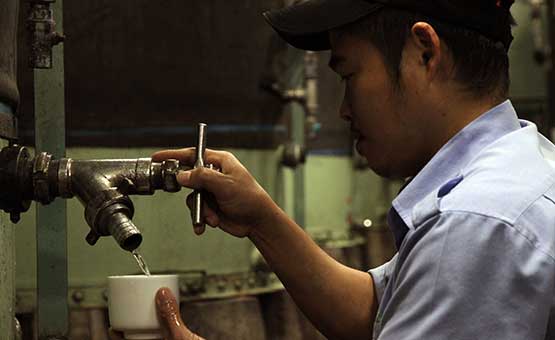Ingredients of Sake are rice and water. In addition to fermentation of “ko-ji kin”, which is kind of bacteria and “yeast”, taste and smell are variable. If you learn how we brew Sake, you can more enjoy drinking Sake.

Generally, more milling rice, sweeter the taste of sake is. “Etsu no Hajime” is 60% reminding of rice (See picture) . “Jo-kun” is 50% reminding rice.

Koji is the most important process in brewing Sake.
1: Washing. Wash rice to remove dust and to be cleaned.
2: Soaking. Before steaming, soak rice. In this procedure, water temperature is important. We keep around 15 degree. It takes 22hours to soak well rice.
3: Steaming. Steaming makes rice soft and soft rice become Koji-Rice easily. It takes about an hour to steam.
4: Making Koji. Koji-kin is added into steaming rice (See picture). Then we must manage temperature from around 36 degree to 42 degree, to monitor how Koji-Rice is. It takes about 48 hours. Koji-rice influences the taste of Sake. Generally, there are 4 types Koji we make to brew Sake; Syubo-Koji, Soe-Koji, Naka-Koji, and Tome-Koji.

This is fermentation term. Koji-Rice and water added into a tank. This fermentation makes alcohol occur. We add 4types Koji-Rice as mentioned above day by day.
1st day, Syubo Koji-Rice, yeast, water and steamed rice are added into a tank.
2nd day, Soe Koji-Rice, water and steamed rice are added into a tank.
3rd day, Nothing to do to ferment Moromi.
4th day, Naka Koji-Rice, water and steamed rice are added into a tank.
5th day, Tome Koji-Rice, water and steamed rice are added into a tank.
After these mentioned above, we manage the temperature of Moromi around 17 degree. It spends from 20 days to 30 days. In case of “Etsuno Hajime”, it takes 28 days to ferment Moromi.

After fermenting Moromi, Sake can be drunk, which called as “Nigori” or “Doburoku”. Sake are mainly filtered. After filtration, Sake is pasteurized to stop fermentation, and moved to a Keeping tank in under 10 degree. When Sake is ordered, we pasteurize Sake after bottling.
As mentioned above, we pasteurize Sake twice. However, “Nama chozou Sake” is only pasteurized after bottling. And “Nama Sake” is neither pasteurized

Sake contains amount of vitamin and mineral. Especially, Sake contains 10 times more amino acid than wine. Furthermore, ferulic acid which is a kind of polyphenol is contained in Sake, which expects the effects for beautiful skins.
For Japanese people, Sake is brewed for Gods to represent “appreciation” for “rice harvest”or “brewing Sake”. In middle ages, Sake is changed to be served for festival and celebration. Sake is called as the symbol of coexistence between human and nature, we believe that Sake is ecological brewage.